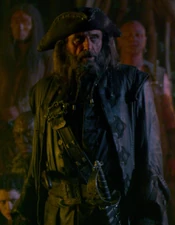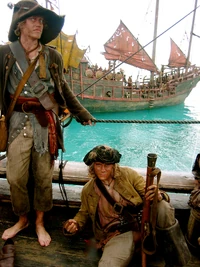- "We're sailing into the heart of the Bahamas, now. Lots of shoals, so we'll anchor by night, and only sail by day. Too risky, otherwise."
- ―Jack Sparrow to Amenirdis
The Bahamas were islands located east of Florida and north of Cuba. Over the course of history, the Bahamas were claimed both by Spain and Great Britain, but their best known inhabitants were pirates of the Caribbean. Although the Bahamas was not geographically located in the Caribbean, it was considered one of the most prosperous parts of the Caribbean region.
History
- "Northwest Providence Channel can be treacherous. The Bahamas have a lot of shoal waters around those islands."
- ―Frank Connery to Cutler Beckett
The Bahamas were discovered by the Spanish in 1492. After decimating the local native population, the Spanish abandoned most of the islands. In 1648, an English group from Bermuda arrived to the Bahamas, settling on the island of Eleuthera and New Providence. As Bermuda was crowded, the Bahamas offering religious and political freedom as well as economic opportunity more settlers followed.
The inhabitants of the Bahamas made their living from the sea, salvaging wrecks of the Spanish Treasure Fleets, making salt, and taking fish, turtles, conchs and ambergris. Farmers from Bermuda soon followed the seamen to New Providence, where they found good, plentiful land. In 1684 the Spanish attacked and burned the settlements on New Providence and Eleuthera. New Providence was settled a second time in 1686 from Jamaica and by 1694 pirates made the town of Nassau their base.

As times past, the Bahamas had seen the likes of such legendary pirates as Henry Jennings, Henry Morgan, Edward "Blackbeard" Teach, Charles Vane, Stede Bonet, Benjamin Hornigold, Woodes Rogers, "Calico Jack" Rackman, John Wyatt, Thomas Austis, Henry Every, Richard Worley, Samuel Belamy and Bartholomew "Black Bart" Roberts.[1]
In 1703 and again in 1706 combined French-Spanish fleets attacked and sacked Nassau. After that, the Bahamas became a Pirate Republic for eleven years. Several pirate captains used the Bahamas as a home port during this period, Edward "Blackbeard" Teach among them.
The "republic" came to an end in 1718, when Woodes Rogers, the first Royal Governor of the Bahamas, reached Nassau with a small fleet of warships. While some pirates sailed off, a few offered a brief resistance. The 300 remaining pirates cheered Rogers and gave their oath to King George, but many soon reverted to their old ways.
During the 1710s the Bahamas were one of the favorite hunting grounds of rogue pirates led by Boris "Borya" Palachnik. It was off the coast of Great Abaco that Borya's ship, the Koldunya, attacked the EITC merchant ship Wicked Wench. However, the pirate ship was destroyed thanks to the magical powers of Ayisha, the Kerman princess who was onboard the Wench.[2] At some point before the Battle of Isla de Muerta, the East India Trading Company sent a fleet of ships to the Bahamas to participate in one of the many conflicts in that area.[3]
Behind the scenes

The trailer for the video game Pirates of the Caribbean: Isles of War sets the EITC invasion of the Bahamas in 1740, "before the events of The Curse of the Black Pearl".[4] However, that date contradicts the rest of the timeline which sets the main events of The Curse of the Black Pearl around 1728.
Some scenes from the 2006 film Pirates of the Caribbean: Dead Man's Chest and the 2007 film Pirates of the Caribbean: At World's End were filmed in the Bahamas, particularly in the Exumas. They include scenes on Isla Cruces and on the Sandbar.[5]
The Bahamas appear in Tim Powers' 1987 novel On Stranger Tides, which was used as the basis for the 2011 film Pirates of the Caribbean: On Stranger Tides.[6]